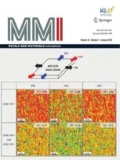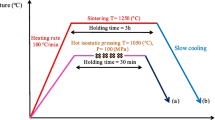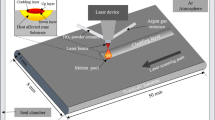Abstract
We studied the origin of different characteristics and properties of a Ti–10V–2Fe–3Al beta (β) titanium alloy with surface height irregularities that occurred during machining. The height differences were observed in two different regions, labeled as “soft region” and “hard region.” The present study showed a higher Fe and a lower Al content in the hard region, which resulted in higher β-phase stability to resist primary alpha (αp) phase precipitation caused by a failure of the solution treatment process. In contrast, the soft region contained a higher volume fraction of αp phase and a lower volume fraction of the matrix, which consisted of a combination of β and secondary alpha (αs) phase. A high number of αs/β interface in the matrix with a predicted hardness of 520 HV generated an improvement of hardness in the hard region. Therefore, the hard and the soft regions had different abilities to resist wear during machining process, resulting in surface height irregularities.









Similar content being viewed by others
References
C. Leyens, M. Peters, Titanium an Titanium Alloys (Wiley, New York, 2003)
G.T. Terlinde, T.W. Duerig, J.C. Williams, Microstructure, tensile deformation, and fracture in aged Ti–10V–2Fe–3Al. Metall. Trans. A 14A, 2101–2115 (1983)
A. Bhattacharjee, Effect of b grain size on stress induced martensitic transformation in b solution treated Ti–10V–2Fe–3Al alloy. Scr. Mater. 53, 195–200 (2005). https://doi.org/10.1016/j.scriptamat.2005.03.039
C. Li, X. Wu, J.H. Chen, S. van der Zwaag, Influence of α morphology and volume fraction on the stress-induced martensitic transformation in Ti–10V–2Fe–3Al. Mater. Sci. Eng. A 528, 5854–5860 (2011). https://doi.org/10.1016/j.msea.2011.03.107
S. Neelakantan, P.E.J. Rivera-Díaz-del-Castillo, S. van der Zwaag, Prediction of the martensite start temperature for β titanium alloys as a function of composition. Scr. Mater. 60, 611–614 (2009). https://doi.org/10.1016/j.scriptamat.2008.12.034
C. Li, J. Chen, W. Li, Y.J. Ren, J.J. He, Z.X. Song, Effect of heat treatment variations on the microstructure evolution and mechanical properties in a beta metastable Ti alloy. J. Alloys Compd. 684, 466–473 (2016). https://doi.org/10.1016/j.jallcom.2016.05.225
L. Xu, Tuning their Beta Phase Stability and Low-Temperature Martensitic Transformation (Delft University of Technology, Delft, 2015)
M. Jackson, R. Dashwood, L. Christodoulou, H. Flower, The microstructural evolution of near beta alloy Ti–10V–2Fe–3Al during subtransus forging. Metall. Mater. Trans. A 36A, 1317–1327 (2005). https://doi.org/10.1007/s11661-005-0282-1
J. Fan, J. Li, H. Kou, K. Hua, B. Tang, Y. Zhang, Influence of solution treatment on microstructure and mechanical properties of a near β titanium alloy Ti-7333. Mater. Des. 83, 499–507 (2015). https://doi.org/10.1016/j.matdes.2015.06.015
Z.X. Du, S.L. Xiao, Y.P. Shen, J.S. Liu, J. Liu, L.J. Xu, F.T. Kong, Y.Y. Chen, Effect of hot rolling and heat treatment on microstructure and tensile properties of high strength beta titanium alloy sheets. Mater. Sci. Eng. A 631, 67–74 (2015). https://doi.org/10.1016/j.msea.2015.02.030
G. Srinivasu, Y. Natraj, A. Bhattacharjee, T.K. Nandy, G.V.S. Nageswara, Rao, Tensile and fracture toughness of high strength β Titanium alloy, Ti–10V–2Fe–3Al, as a function of rolling and solution treatment temperatures. Mater. Des. 47, 323–330 (2013). https://doi.org/10.1016/j.matdes.2012.11.053
A.C. Van Arkel, History and Extractive Metallurgy (Wiley, New York, 2015)
S. Seong, O. Younossi, B.W. Goldsmith, Titanium Industrial Base, Price Trends, and Technology Initiatives (RAND Corporation, Santa Monica, 2009)
A.J. Wilby, D.P. Neale, Defects Introduced into Metals During Fabrication and Service (Eolss Publishers, Oxford, 2009)
R.R. Moura, M.B. da Silva, Á.R. Machado, W.F. Sales, The effect of application of cutting fluid with solid lubricant in suspension during cutting of Ti–6Al–4V alloy. Wear 332–333, 762–771 (2015). https://doi.org/10.1016/j.wear.2015.02.051
J. Satoh, M. Gotoh, Y. Maeda, Stretch-drawing of titanium sheets. J. Mater. Process. Technol. 139, 201–207 (2003). https://doi.org/10.1016/S0924-0136(03)00220-6
J.D. Beal, R. Boyer, D. Sanders, T.B. Company, Forming of titanium and titanium alloys. ASM Handb. Metalwork. Sheet Form. 14B, 656–669 (2006). https://doi.org/10.1361/asmhba0005146
J.D. Cotton, R.D. Briggs, R.R. Boyer, S. Tamirisakandala, P. Russo, N. Shchetnikov, J.C. Fanning, State of the art in beta titanium alloys for airframe applications. JOM 67, 1281–1303 (2015). https://doi.org/10.1007/s11837-015-1442-4
H.F. Wu, L.L. Wu, W.J. Slagter, J.L. Verolme, Use of rule of mixtures and metal volume fraction for mechanical property predictions of fibre-reinforced aluminium laminates. J. Mater. Sci. 29, 4583–4591 (1994). https://doi.org/10.1007/BF00376282
M.A. Ghafaar, A.A. Mazen, N.A. El-Mahallawy, Application of the rule of mixtures and Halpin-Tsai equations to woven fabric reinforced epoxy composites. J. Eng. Sci. 34, 227–236 (2006)
K.K. Chawla, The Applicability of the “rule-of-mixtures” to the strength properties of metal-matrix composites. Rev. Bras. Fís. 4, 411–418 (1974)
J.P. Angle, Z. Wang, C. Dames, M.L. Mecartney, Comparison of two-phase thermal conductivity models with experiments on dilute ceramic composites. J. Am. Ceram. Soc. 96, 2935–2942 (2013). https://doi.org/10.1111/jace.12488
N. Poondla, T.S. Srivatsan, A. Patnaik, M. Petraroli, A study of the microstructure and hardness of two titanium alloys: Commercially pure and Ti–6Al–4V. J. Alloys Compd. 486, 162–167 (2009). https://doi.org/10.1016/j.jallcom.2009.06.172
S.S. Da Rocha, G.L. Adabo, G.E.P. Henriques, M.A.D.A. Nóbilo, Vickers hardness of cast commercially pure titanium and Ti–6Al–4V alloy submitted to heat treatments. Braz. Dent. J. 17, 126–129 (2006). https://doi.org/10.1590/s0103-64402006000200008
A.F. Gerday, M. Ben Bettaieb, L. Duchene, N. Clement, H. Diarra, A.M. Habraken, Material behavior of the hexagonal alpha phase of a titanium alloy identified from nanoindentation tests. Eur. J. Mech. A. Solids 30, 248–255 (2011). https://doi.org/10.1016/j.euromechsol.2010.11.001
Y. Ji, T.W. Heo, F. Zhang, L.Q. Chen, Theoretical assessment on the phase transformation kinetic pathways of multi-component Ti alloys: Application to Ti–6Al–4V. J. Phase Equilib. Diffus. 37, 53–64 (2016). https://doi.org/10.1007/s11669-015-0436-9
M. Motyka, K. Kubiak, J. Sieniawski, W. Ziaja, Phase transformations and characterization of α + β titanium alloys. Compr. Mater. Process. (2014). https://doi.org/10.1016/B978-0-08-096532-1.00202-8
G. Lütjering, J.C. Williams, Titanium, Engineering Materials and Processes (Springer, Berlin, 2007)
P. Castany, J. Douin, A. Coujou, In situ transmission electron microscopy deformation of the titanium alloy Ti–6Al–4V : interface behaviour. Mater. Sci. Eng. A 484, 719–722 (2008). https://doi.org/10.1016/j.msea.2006.10.183
Acknowledgements
This study was supported by the 2016 Yeungnam University Research grants.
Author information
Authors and Affiliations
Corresponding authors
Electronic supplementary material
Below is the link to the electronic supplementary material.
Rights and permissions
About this article
Cite this article
Utama, M.I., Ammar, A.A., Park, N. et al. Origin of Surface Irregularities on Ti–10V–2Fe–3Al Beta Titanium Alloy. Met. Mater. Int. 24, 291–299 (2018). https://doi.org/10.1007/s12540-018-0042-6
Received:
Accepted:
Published:
Issue Date:
DOI: https://doi.org/10.1007/s12540-018-0042-6




